One of the biggest lessons I've learned running my freelance content business is that while marketing and branding can get leads to your storefront, social proof is what will help you convert them into customers.
In fact, a study by PowerReviews found that 90% of customers read reviews before deciding to make a purchase.
With online shopping skyrocketing and the competition becoming fiercer, it‘s more important than ever to incorporate social proof into your acquisition strategy. In this article, I’ll explain the psychology of social proof and how you can employ your customers to help you crush your sales and conversion goals.
Table of Contents
.png)
Free Customer Referral Templates
45 email & social media templates to ask for referrals and spread the word about referral programs
- Email Templates to Ask for a Referral
- Email Templates for Following Up with a Referral
- Social Copy Templates About a Referral Program
- And More!
Download Free
All fields are required.
.png)
What is social proof?
Social proof, a term coined by psychologist Robert Cialdini, describes how people respond when they don't know how to act in a particular situation.
Much of what makes social proof work is rooted deep in human psychology. Rather than relying on our knowledge or intuition, we look to other people for guidance on what we should do. It’s like going to a party, seeing what people are doing, and modeling your behavior accordingly.
Social proof, when used for marketing, can be a powerful tool. In a sense, social proof plays off our desire to fit in. We want to make decisions that our peers support and will help them accept us. This doesn't just apply to how we behave in public — it also directly influences what we buy.
Benefits of Social Proof
From my experience of dealing with prospects on a daily basis, I have observed that social proof is most powerful when an individual is uncertain, like when making a buying decision. Our natural, comfortable response is to look at what others are doing as guidance for what we should do ourselves.
Additionally, while we tend to value the opinions of those who seem similar to ourselves, the more people share a particular sentiment, the more influential the social proof becomes. So, I believe that banking on social proof to help sell your product or service is a great move, and plenty of benefits exist.
1. Increase Conversion Rates or Sales
When purchasing, buyers let other people’s opinions determine how they spend their money. Nearly 58% of customers will pay more for a product or service with good reviews. From my experience, I can confidently say that asking your customers for a positive review pays dividends. Doing so will likely increase your sales or conversion rates.
Additionally, you need to understand that the impact of social proof on your conversion rates is not limited to just having good reviews. I've found that the timing and placement of these testimonials are also very important. For instance, moving your customer reviews right next to your call-to-action (CTA) could boost your conversions significantly.
2. Establish Credibility
When customers post reviews of your company (good or bad), they help you gain credibility with your audience and client base. While negative reviews might not seem beneficial, 72% of customers say they help provide a comprehensive look at a company’s product or service, helping them make buying decisions.
3. Increase Social Presence
I can‘t stress enough how important having an online brand presence is in today’s digital world. You can incorporate social proof on your digital channels to stand out from the competition. With more customers reviewing your company online, you can easily reach a broader market.
Sharing user-generated content (UGC) on your social media channels can also be a very effective means of social proof. I have personally worked with clients who have built their whole social media strategy based on UGC. And I believe it is for the right reasons: 40% of customers state that UGC is “extremely” or “very” important when making a purchase decision.
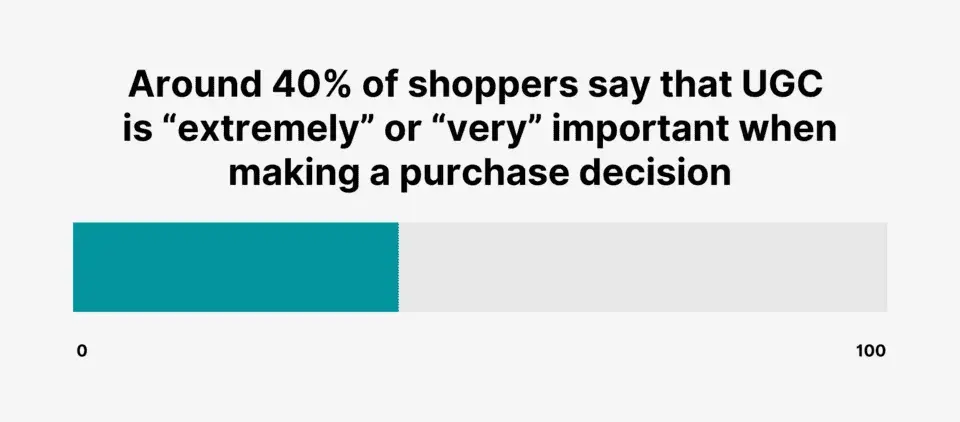
4. Reduce Customers’ Anxiety
I have noticed that, for customers on the fence about taking a chance with your product or service, boosting your positive reviews can help reduce customers’ anxiety. Nearly 74% of customers say that a positive review helps build trust in a company, making it more likely customers will click the “buy now” button.
5. Build Brand Awareness
Like it or not, a company’s reputation is often based on what its consumers say about it online. Social proof, like positive customer testimonials, reviews, and endorsements, can help create awareness about your brand.
I have also seen brands partnering with micro-influencers to review products to show social proof and build brand credibility online. In fact, 36% of millennial consumers state that partnering with influencers will influence their buying decisions.
How to Generate Social Proof
Businesses have used social proof to sell their products and services long before it became a trending term. Ad campaigns with phrases like “Four out of five dentists recommend…” were an attempt at leveraging social proof.
These days, however, I find customers more likely to turn to their peers when deciding to buy a product or service that's new to them. In our increasingly digital world, that means looking at reviews on Google, Facebook, Reddit, and other platforms for recommendations.
Reviews have become so crucial to the buying process that BrightLocal reports 75% of consumers “always” or “regularly” look at online reviews when researching local businesses, with the average person reading 10 reviews before they feel they can trust an organization.
But, while most customers consider reviews a trusted source of information, some are going to leave one only if you're proactive and request it. While 23% of customers have never left an online review, most said they would be willing to write one in the future — as outlined in the chart below.
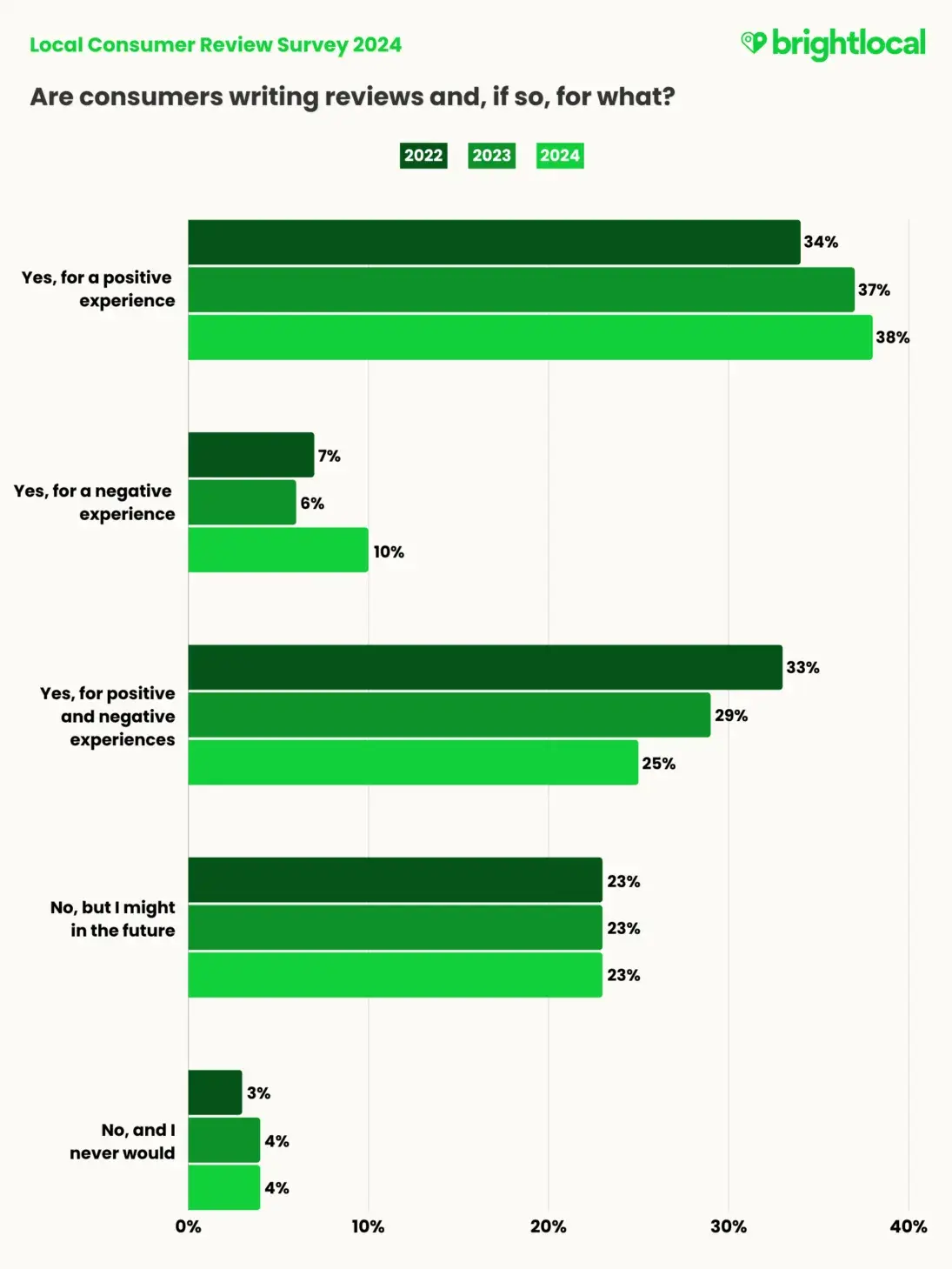
Offering incentives in exchange for taking the time to leave a review has become a common practice today. However, here is something that I found very interesting.
Research from the Harvard Business Review shows this idea isn’t always the best course to follow because it can lead to high acquisition costs — and not stellar reviews. Instead, the study suggests that sending a follow-up email to your customers asking for a review is an effective enough way to collect them.
Social Proof Ideas
Now that you understand the importance of social proof, are you wondering what type of social proof you need to collect for your business?
In this section, I have listed a few social proof ideas that you can use to boost your brand credibility.
1. Customer Reviews
Customer reviews are basically honest customer feedback on your products or services. These reviews can be used directly on your website or incorporated into your marketing assets.
From my experience, the best way to collect reviews is to send your customers follow-up emails, nudging them to provide reviews.
Here is an interesting fact I found in the same Harvard Business Review article. It states that customers are more likely to provide a review only if they are extremely happy about the product/service or extremely disappointed. And these customers account for a small percentage of your total customers.
So, if you want the remaining customers to provide a review, you need to ask them. (Maybe more than one time, if required.)
2. Video Testimonials
Video testimonials are short clips of customers sharing their experiences about your product/service.
But are video testimonials really necessary when text testimonials are much easier to source and use?
Well, here is a statistic that caught my attention. Adding video testimonials can increase the organic search traffic to your website by as much as 157%.
However, sourcing video testimonials can be a challenge in itself. Your customers might not have the time or may not be comfortable speaking in front of the camera without proper instructions.
During my conversation with Aneta Poplavska, the marketing and communications manager at The HMO Mortgage Broker, she mentioned that they had figured out a solution to this.
She said, “We‘re in the process of gathering video testimonials, and we’ve noticed some hesitation from our clients. Some are camera shy, while others find the prep time challenging.”
To address this, Poplavska says her team takes steps to make clients more comfortable.
“We offer to do the recording at their office or a location of their choice, provide questions in advance, and even do practice runs to help them feel more at ease,” Poplavska says.
Although more difficult to source, video testimonials can definitely pay off!
3. Case Studies
Case studies are documentation of how your business solved a specific problem for a client.
In my experience, case studies might require a lot more work than just asking clients for feedback. It requires you to conduct in-depth interviews with your clients to gather a lot of information. Once you have all the data, then you need to structure it in a way that is easier for your prospects to understand.
Mary Zhang, head of marketing and finance at Dgtl Infra, states, “We gather case studies through a systematic process. After successful project completions, our account managers conduct in-depth interviews with clients, focusing on quantifiable results and overcoming challenges.”
Zhang’s team recently automated this process, triggering a case study request 30 days after project completion. This has increased the company’s case study production by 50%.
“The impact on our business has also been significant. After featuring one of our recent case studies prominently on our website and in sales pitches, we saw a 35% increase in inquiries for similar services. This single case study directly led to three new enterprise contracts worth over $2 million,” Zhang says.
So even though case studies can be more intensive to make, they can pay off big time if done well.
4. User-Generated Content
As the name says, this is content created by your customers featuring your product/service.
You can encourage your customers to share UGC and mention you on their social handles (offering them little incentives wouldn't hurt). You can also use social listening tools like HubSpot Social Media Management Software to monitor if any of your customers are talking about your product.
Here is an interesting insight Gary Hemming, owner and finance director of ABC Finance, shared with me on how they source their UGC.
He mentioned, “Following successful funding, our clients often share their accomplishments with their LinkedIn networks. While this is not the typical Instagram-style user-generated content, it is ideal for our professional niche.”
Hemming’s team discovered that clients were willing to share these stories since it helped their own business credibility.
“When they tag us, we get visibility to their professional networks, which are exactly the people we want to target. One client's LinkedIn post drew more than 30 inquiries from organizations in similar sectors,” Hemming says.
Also, resharing and promoting UGC on your social pages encourage more participation in hopes of being put in the spotlight.
5. Net Promoter Score (NPS)
NPS is a metric that measures customer loyalty and satisfaction. You have to basically send out an NPS survey form for your clients and ask them to rate your service from 0-10. Once you have this data, you can display it on your websites or use it in your marketing materials.
There are other ways you can leverage NPS to build your social proof, too. In my conversation with Nora Sudduth, founder and owner of Nora Sudduth Consulting, she mentioned, “When a client has a high NPS score, we send them a personalized message thanking them and asking if they'd be interested to provide a testimonial or share their experience with their network.”
According to Sudduth, this leads to organic referrals, which have accounted for approximately 20% of the company’s new business in the last year.
“It‘s an authentic form of social proof because it’s driven directly by satisfied clients,” Sudduth says.
.png)
Free Customer Referral Templates
45 email & social media templates to ask for referrals and spread the word about referral programs
- Email Templates to Ask for a Referral
- Email Templates for Following Up with a Referral
- Social Copy Templates About a Referral Program
- And More!
Download Free
All fields are required.
.png)
Social Proof Best Practices
1. Devise a system for collecting customer reviews.
I‘ve observed that positive reviews on Google or Facebook can dramatically influence a customer‘s decision to buy from you — especially if you have many of them. The previously cited BrightLocal data also suggests that most customers won’t trust a business’s overall rating unless it draws from 40 or more reviews.
Because of this, your first step for leveraging social proof should be devising a system for collecting reviews. Simple steps like claiming your profile on third-party review sites or adding a review link to in-store and digital receipts will help you collect more reviews across multiple platforms. I would also recommend using an automated email request to serve as a powerful reminder.
2. Publish testimonials on your brand's website and social media accounts.
I strongly advise that you incorporate social proof into your brand's online media. On-site testimonials can be particularly effective on landing pages, turning customer experiences into visually engaging elements on your website. You can also publish them on Facebook, X, or Instagram, as testimonials and reviews are perfectly suited for your social media campaigns.
A testimonial could be as simple as a featured quote paired with an image of the satisfied customer. Or, you could take things a step further by transforming the testimonial into a video or case study. The image below shows one example of what a testimonial can look like.

I've learned firsthand that adding social proof to your landing pages and digital campaigns will be far more influential than a scripted marketing message could ever be. In fact, a case study for WikiJob also found that simply adding a few short, text-only testimonials to its landing page increased sales by 34%.
3. Focus on reviews that highlight specific details about your company.
The more specific a review is and the more closely aligned it is to your messaging goals, the more effective it will be for your campaign.
For example, WikiJob is designed to help job candidates in the United Kingdom prepare for interviews and aptitude tests. One of the testimonial quotes it promotes is, “Almost a carbon copy of the real aptitude test.” In my opinion, this is a highly valuable review that demonstrates its worth to potential customers.
I highly recommend you consider this when you solicit customers for feedback. Ask them to share specific details about what they liked about their experience, and you'll obtain information-rich reviews that are more persuasive and convincing.

4. Partner with influencers within your niche.
I've observed that a glowing review from an influencer within the industry is a great way to boost social proof. Influencers are well-known for being able to connect with their audiences, which is good news for brands because 69% of people are more likely to pay attention to authentic and relatable marketing videos compared to polished, high-quality videos.
However, before you partner with just any influencer, I strongly advise that you do your research and ensure the influencer’s audience is your target audience and aligns with your brand’s mission. No matter how positive the review, there is nothing worse than marketing to the wrong audience.
5. Display industry seals and certifications.
Social proof is more than just positive reviews. Customers are also impressed with businesses’ certifications and other seals of trust, like ecommerce badges. I've personally discovered that ecommerce badges help customers feel safe sharing their personal banking details with your company and let them know of any money-back guarantees you might offer.
So, make sure to include these items on your landing pages, product pages, and checkout pages.
6. Respond to negative reviews about your brand.
No one likes a negative review. And let’s be honest, a negative can sting a little, especially when you’ve spent so much time developing your company’s brand. However, bad reviews sometimes happen. When they do, one bad review has the potential to deter consumers from doing business with your brand.
I think it‘s very important how you respond to these negative reviews. Publically and professionally addressing these issues can itself be a social proof of your brand’s willingness to work towards customer needs. In fact, promptly responding to negative reviews can help lead 45% of consumers back to your business.
7. Use feedback from specific demographics to target that customer demographic.
Here is a secret tip I want to share with you. Always add social proof collected from the types of customers you want to attract to your business.
If you want to work with the founders and CEOs, then you need to show social proof given by founders and CEOs.
Here is what Jonathan Murphy, founder of Body Mentors, shared in his conversation with me about how social proof helped them target customers from a specific age group.
He stated, “We found that older clients were very hesitant to try strength training and believed it was something only suitable for people under 50. By including a couple of our older client success stories, we've found this content to be the most common reason new clients have booked a free taster session.”
Social Proof Examples
1. Canva
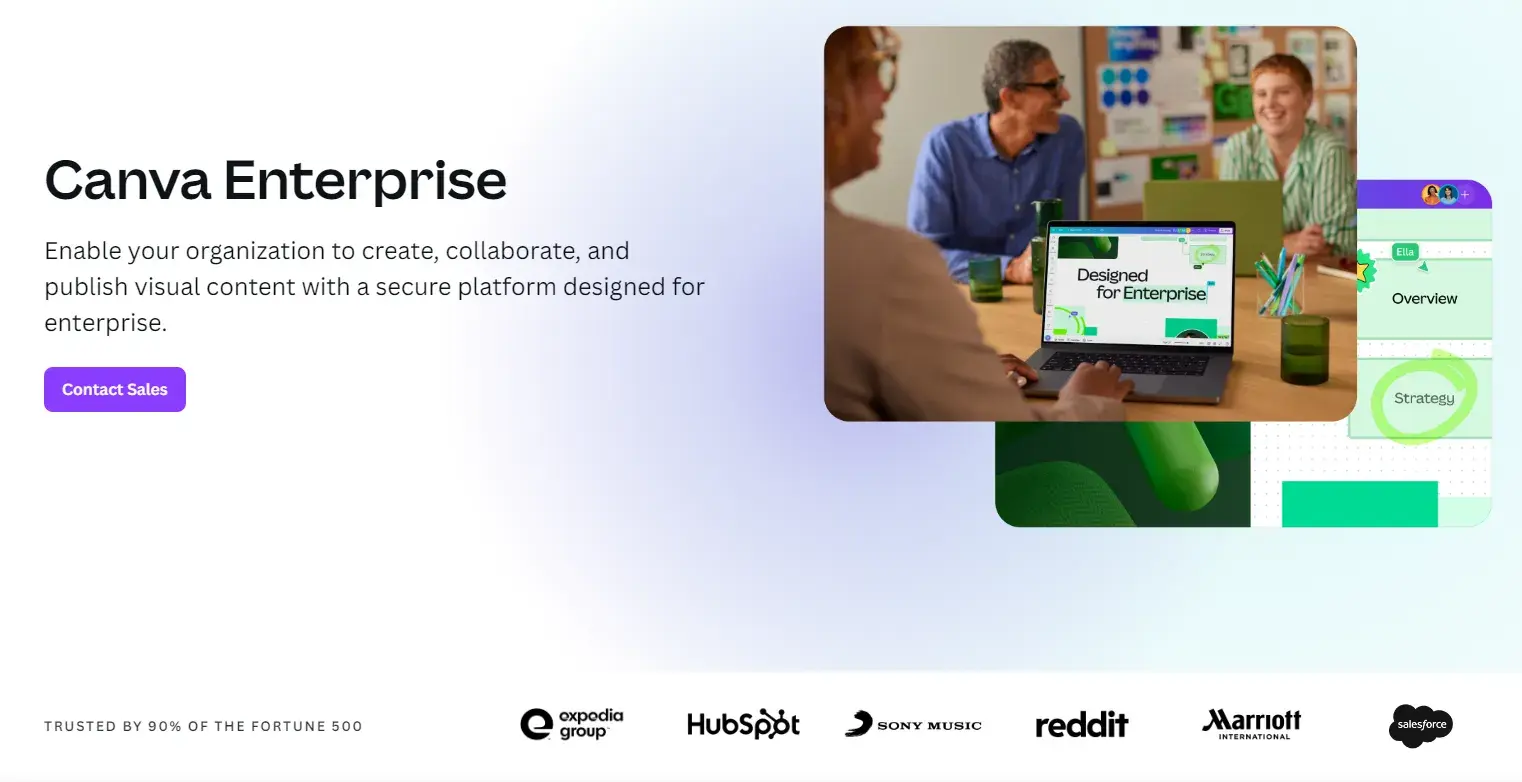
Canva, a well-known visual suite for designers, effectively employs social proof by adding a scrolling banner of brands that have used the platform (even HubSpot!).
I love how the scrolling banner says, “Trusted by 90% of the Fortune 500.” It conveys the message, “If popular Fortune 500 companies are using Canva, then we must, in fact, be a great investment for you, too!”
What I like: I really liked how the website opens with the scrolling banner of all the top brands that use Canva. However, what impresses me more is that as you scroll down, you'll find these testimonials from those who use the tool, making the social proof even more solid. Additionally, the numbers above are the icing on the cake.
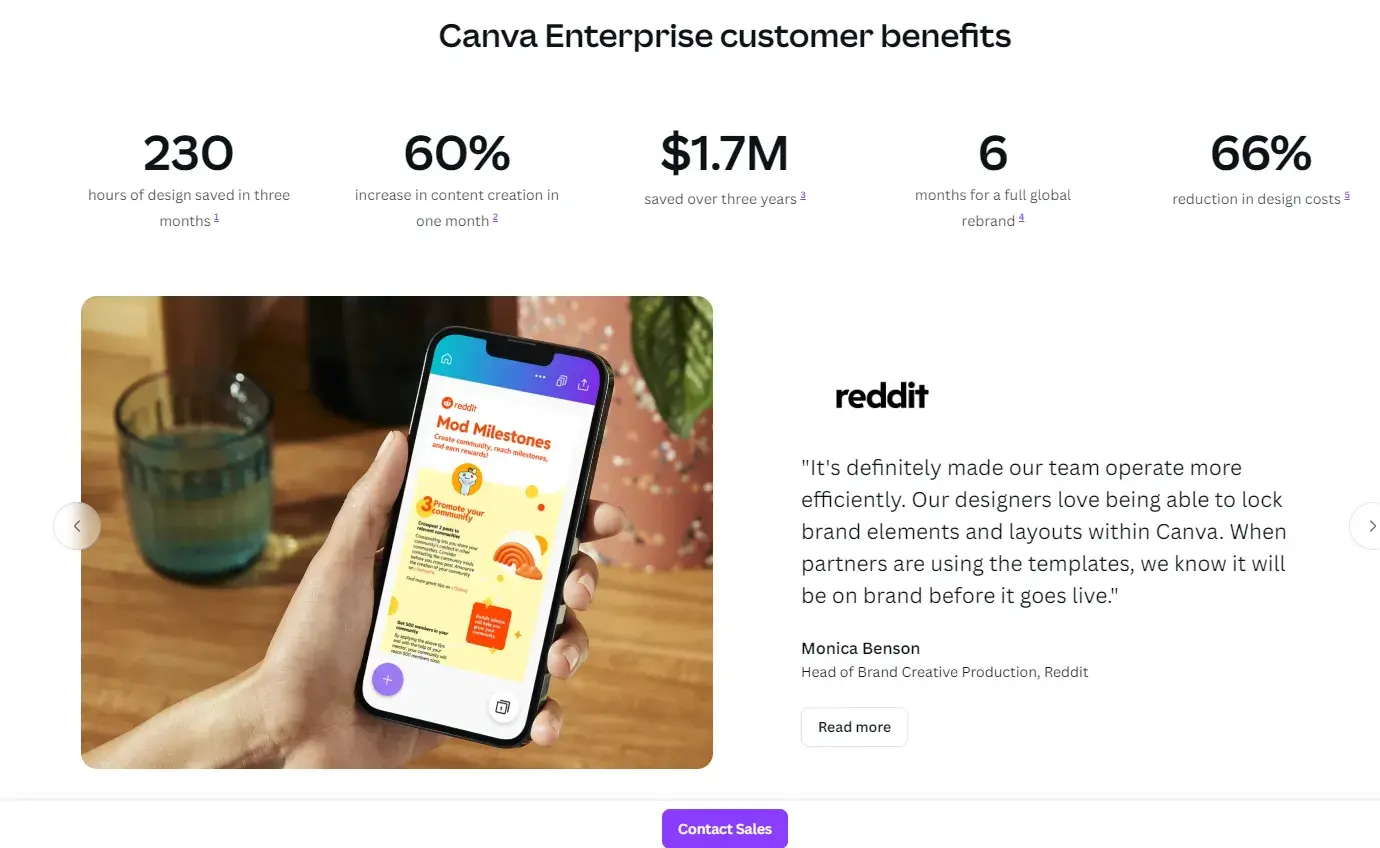
Pro tip: If you’re a B2B company, I highly recommend you ask for logos from the brands who you work with. That way, you’ll have a collection of logos to add to your own banner for social proof.
2. Elna Cain

Elna Cain is a freelance writer and blogger who knows a thing or two about social proof. At the top of her homepage, in the menu bar, she links to her noteworthy praise.
What stood out for me was that Elna has dedicated a whole page to share testimonials. This not only makes it easy for the viewers to spot but her collection of testimonials also helps her stand out to those looking to hire her as a writer.
What I like: I like that Elna Cain includes both the title and a photo of the person who has left her a review. This helps the reader feel as if the person giving the review is a real person.
Pro tip: Always display your testimonials or reviews on your website in a place that is easy to find. In my experience, customers likely will not spend time looking for glowing reviews if they are hidden on your web page.
3. Dyson

Dyson relies on the five-star rating system and customer reviews to help create buyer trust. I think this kind of social proof is most commonly recognizable for shoppers, as most companies employ the same type of rating system. A star system is easy to understand and does not leave customers confused about a product's rating.
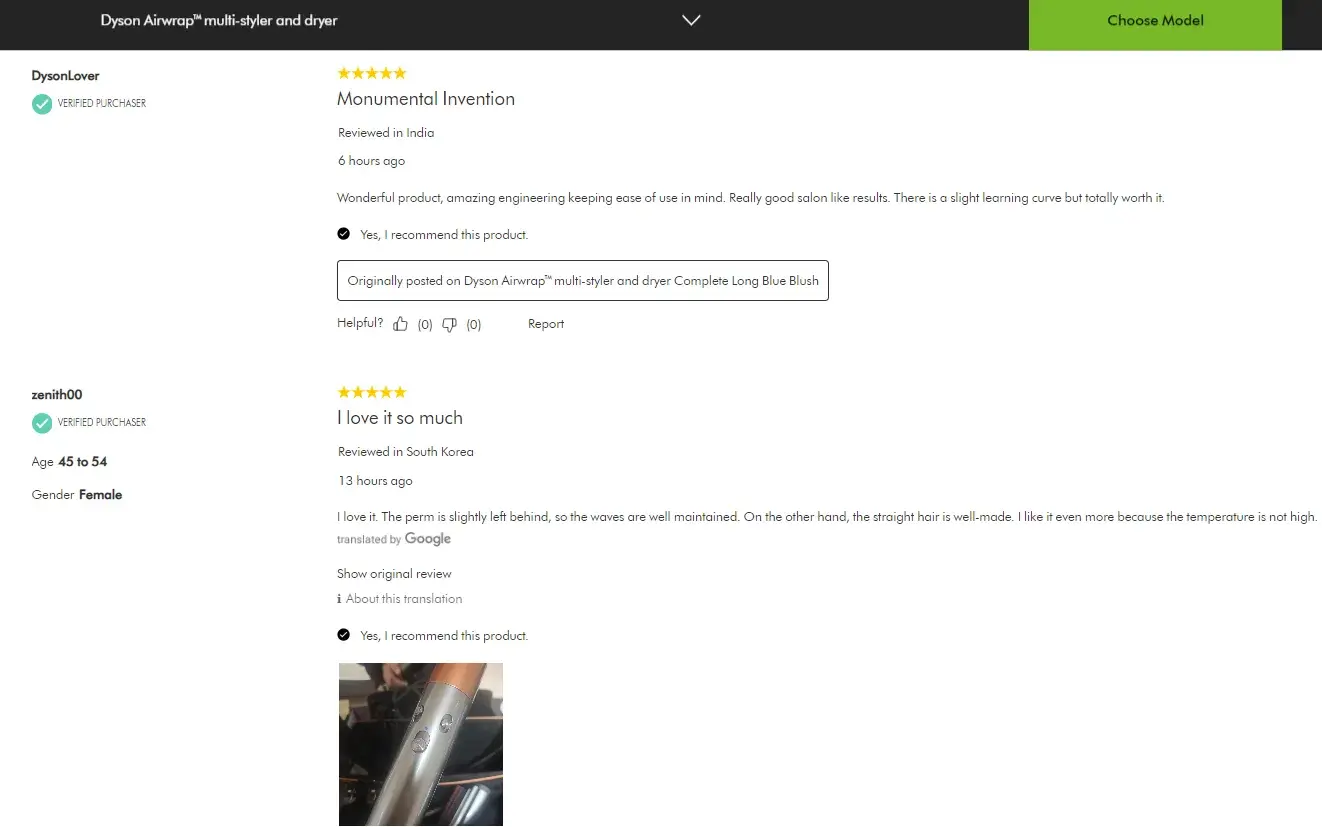
I‘m really impressed by how confident Dyson is about their product. You can see that they have collected data about how many reviewers would recommend the product to friends and openly posted it on the product page. This also becomes a type of social proof that elevates the product’s credibility.
What I like: I like that Dyson puts their product reviews right at the top of the product listing. This makes it easy for customers to find and read reviews without endless scrolling to get to the bottom of the page.
Pro tip: Always ask your customers for a review of your product or service. Don’t forget to send follow-up emails to customers who did not leave a review after the initial email!
4. ThriftBooks
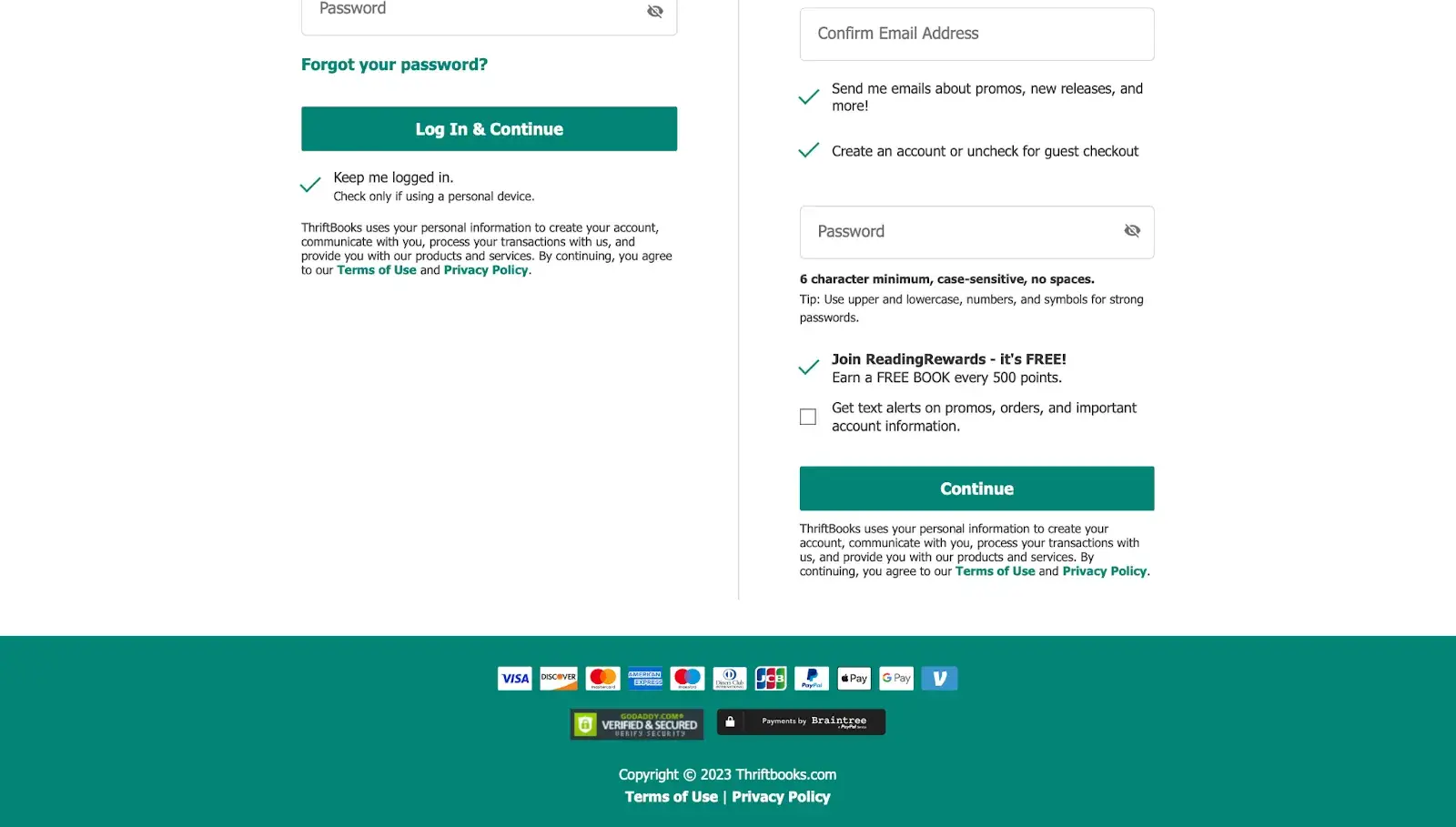
ThriftBooks, an online bookstore, knows social proof is not just about ratings and reviews. Instead, social proof also considers things like verification badges and confirmation of a secure checkout.
From what I've seen, customers need to know the website is safe and secure before submitting any personal information, like their banking details or address. ThriftBooks uses the footer of their website as a display of their verification badges, while also letting the customer know which major credit cards they accept as payment.
What I like: ThriftBooks wisely uses the footer of their website to display their verification badges. These types of badges and verification certificates are important, but they also shouldn’t be front and center. Other things, like reviews and testimonials, should be higher up on the web page.
Pro tip: If you are an ecommerce brand or you accept payment on your website, I highly recommend you include verification badges to let the customer know your website is secure.
How to Measure Social Proof
You have collected your social proof and used it thoroughly on your websites and social media platforms. Is your job done here? Nope.
My advice would be to constantly measure the impact your social proof is having on your business. This helps you iterate your strategy if certain social proofs are not getting you the desired results.
Let me explain how you can analyze the effectiveness of your social proof.
Identify Key Performance Indicators (KPIs).
Before you start measuring, I suggest you determine which metrics are important to your business goals. It can be anything from conversion rate and total sales to engagement rate on your social media channels.
Set up analytics tools.
Once you know which metrics you need to track, I think it is time to set up your analytics tools to track them.
Here are a few of my recommendations:
- Google Analytics. Set up conversion tracking in Google Analytics to monitor website traffic trends and track user engagement.
- Social media analytics. Use tools specific to each platform, such as Meta Insights, to gauge audience engagement on social media.
- Heat mapping tools. Use heat mapping tools, such as Hotjar, to track user interactions on web pages featuring social proof.
Compare impact with historical data.
Once you have set up your analytics tools, I suggest comparing your insights with past data. This gives you a better idea of how well your social proofs are performing.
Experiment with your social proofs.
My experience with social proofs has taught me that you can‘t just upload it once and forget. You must constantly experiment and monitor what works and what doesn’t.
Crouse Wong, the founder of Beltbuy, states, “We track the pages that get the most conversions and correlate that with where customer reviews are placed. We've seen an increase in sales of about 20% for products with strong, positive reviews.
“Additionally, we track engagement metrics to see how many potential customers read through reviews or testimonials before making a purchase. This data helps us refine our strategy and emphasize social proof further.”
Using Social Proof for Successful Scaling
While customer feedback helps you improve products and services, it‘s also a very powerful acquisition tool.
I‘ve learned this the hard way, but you don’t have to — prioritize collecting social proof for your business. By doing so, you are collecting marketing materials that are far more convincing than any scripted advertising campaign.
By leveraging the testimonials of those who have already used your business, everything else your brand tries to communicate will be that much more effective.
Editor's note: This article was originally published September 2020 and has since been updated for comprehensiveness.
.png)
Free Customer Referral Templates
45 email & social media templates to ask for referrals and spread the word about referral programs
- Email Templates to Ask for a Referral
- Email Templates for Following Up with a Referral
- Social Copy Templates About a Referral Program
- And More!
Download Free
All fields are required.
.png)
.png?width=112&height=112&name=Image%20Hackathon%20%E2%80%93%20Vertical%20(11).png)


![7 Customer Acquisition Challenges You Might Face This Year [New Data]](https://www.hubspot.com/hubfs/customer%20acquisition%20%20%281%29.webp)








